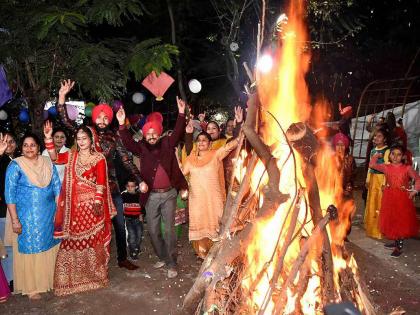Lohri 2024: History and Significance of the Auspicious Festival
By Lokmat English Desk | Updated: January 9, 2024 12:48 IST2024-01-09T12:46:27+5:302024-01-09T12:48:32+5:30
Lohri, the harvest festival of north India, will be celebrated on January 14 this year. Also called 'Lohadi' or ...

Lohri 2024: History and Significance of the Auspicious Festival
Lohri, the harvest festival of north India, will be celebrated on January 14 this year. Also called 'Lohadi' or 'Lal Loi', Lohri is mostly celebrated in Punjab, and also in nearby states of Haryana, Delhi, and Himachal Pradesh. Observed by Hindu and Sikh communities, celebrations of Lohri involve lighting a holy bonfire, gathering around it, and offering prayers and food to the fire God. It is a time when people express gratitude for the harvest and pray for prosperity.
Mahurat
For Lohri 2024, it is essential to note the auspicious timings. As per Drik Panchang, the Tritiya tithi prevails until 07:59 am on January 14, followed by the Chaturthi tithi until 04:59 am on January 15. The Brahma Muhurta, considered a spiritually significant time, is from 05:27 am to 06:21 am. Additionally, the Abhijit Muhurta, a favourable period for conducting auspicious activities, falls between 12:09 pm to 12:51 pm.
History Of Lohri
The story behind Lohri is deeply rooted in folklore and mythology, often associated with the tales of Dulla Bhatti. Dulla Bhatti was referred to as Robin Hood of Punjab.Another aspect tied to Lohri is its association with the winter solstice, the shortest day and longest night of the year. Lohri is celebrated on the night before Makar Sankranti, a day when the sun begins its journey towards the northern hemisphere, marking the end of winter and the onset of longer days.
Why is Lohri celebrated?
Lohri is a special festival associated with the sowing and harvesting of crops. It also heralds the arrival of warmer weather as the days get longer and the nights shorter after Makar Sankranti, which falls a day after Lohri. The same concept is represented by the bonfire lit during the festival celebrations. On the occasion of Lohri, people offer prayers to the Sun God (Surya Devta) and Fire God (Agni Devta), worship the new crop, light a fire outside their homes, and make wishes for a bountiful harvest for the next year. To the Lohri bonfire, they also offer bhog made from the harvested crops, rewadi, groundnut, jaggery, gajak, and peanuts.
Open in app